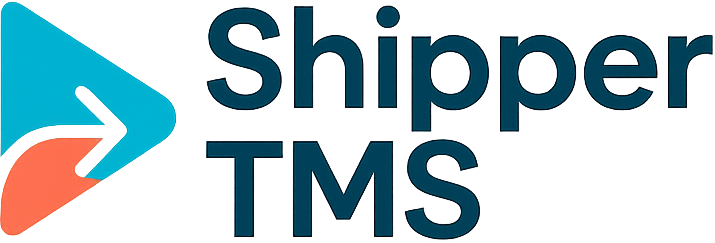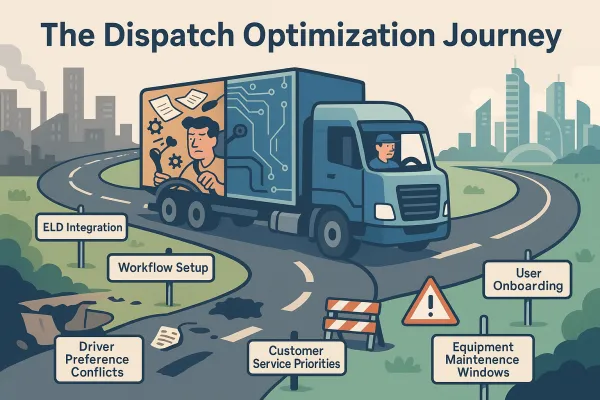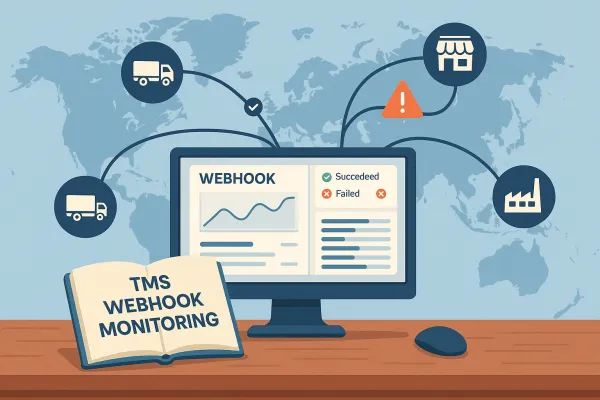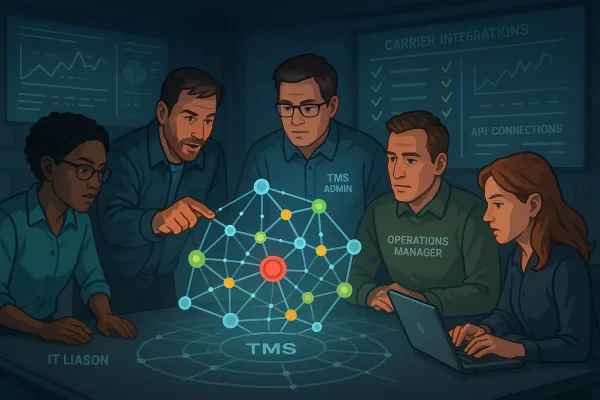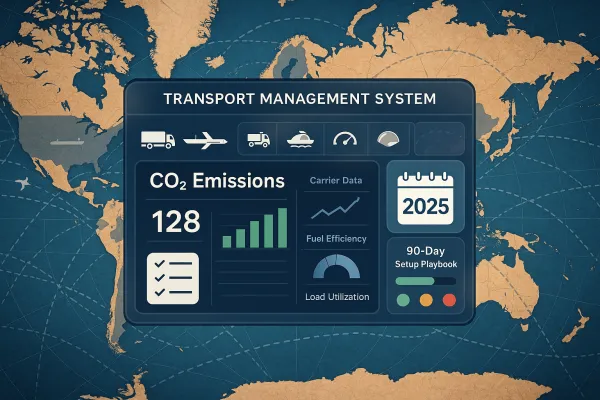TMS Compliance Automation: The 30-Day Framework for EU Emissions Reporting Without Manual Overload
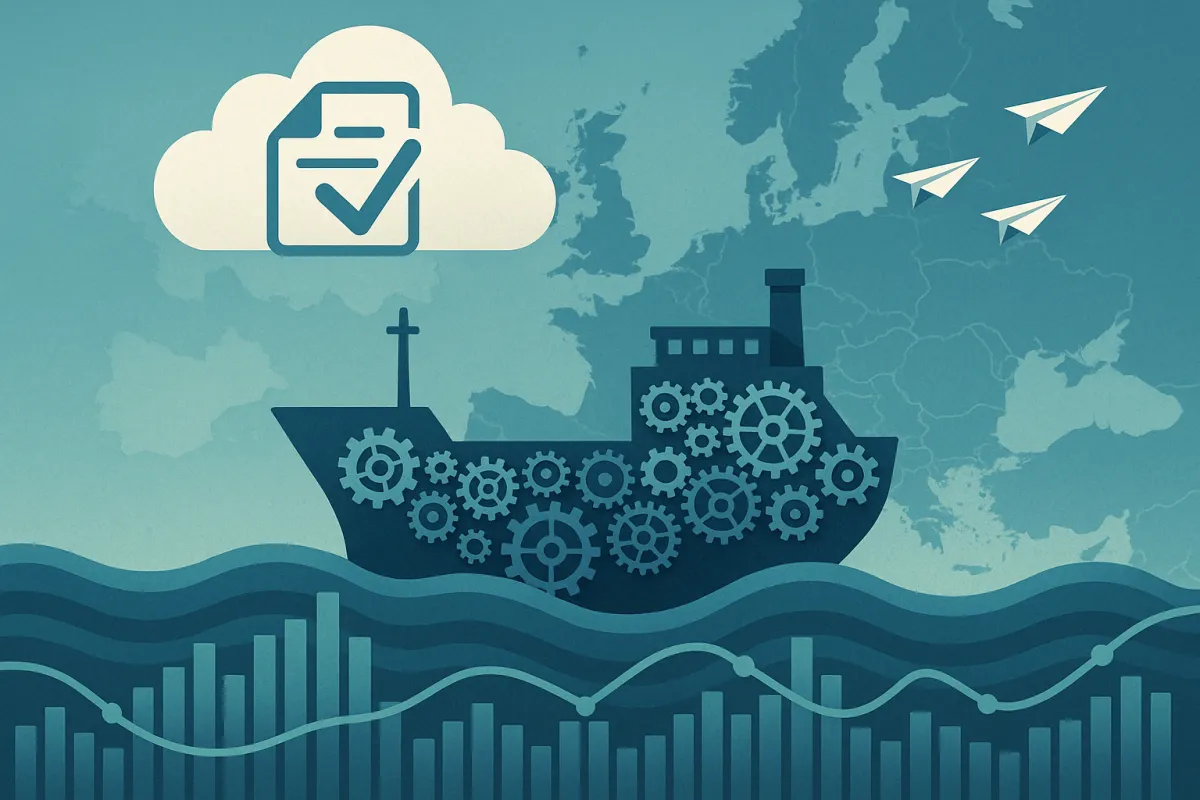
When your shipping operation logs its first 2025 emissions report in March, you'll discover what thousands of EU companies already know: manual compliance tracking becomes impossible once you're handling CSRD requirements for Paris Agreement-aligned emissions reduction plans by 2050, including scope 3 emissions reporting.
The math alone tells the story. Maritime operators must surrender their first EU ETS allowances by September 30, 2025 for emissions reported in 2024, while simultaneously managing FuelEU Maritime requirements that mandate 2% GHG intensity reduction by 2025, scaling to 80% by 2050. Your operations team can't handle this volume manually.
The 2025 Compliance Reality: Why Manual Processes Won't Scale
Shipping companies now surrender allowances for 70% of their 2025 emissions, up from 40% in 2024, creating an immediate cost impact. Maersk expects emission surcharges in 2025 to be nearly double those of 2024. Your current spreadsheet-based reporting won't survive this scaling challenge.
The regulatory convergence creates perfect timing pressure. Large companies already reporting under NFRD must comply with CSRD for FY2024, with reports due in 2025, while maritime emissions reports are due by March 31, 2025. Different deadlines, overlapping data requirements, exponential complexity.
What's Actually Required (And When)
Start with the hard deadlines. Companies failing to complete verifications at both vessel and company levels by March 31, 2025, will be restricted from conducting EUA transactions. Registration cutoffs matter: companies without a MOHA account should contact their designated Administering Authority to register before March 31, 2025.
The data requirements expand beyond basic CO2 tracking. Starting in 2025, methane (CH₄) and nitrous oxide (N₂O) reporting become mandatory, with specific calculation formulas: CH₄ emissions using Fuel Consumption × EFCH₄ × 28, and N₂O emissions using Fuel Consumption × EFN₂O × 265.
Notice the complexity layering. CSRD requires companies to disclose scope 1, scope 2, and scope 3 carbon emissions, with the EU providing a one-year grace period on scope 3 reporting for companies with fewer than 750 employees. Multiple standards, different grace periods, shared underlying data.
The Automation Framework: 4 Core Workflows to Configure
Your TMS already captures shipment data, carrier selections, and route optimizations. The key is extending these existing workflows to automatically generate compliance-ready emissions data without creating parallel processes.
This means configuring four interconnected automation layers that transform operational data into regulatory reports. Each layer builds on TMS data you're already collecting, but adds the precision and auditability that regulations demand.
Workflow 1: Automated Data Ingestion from Carrier Systems
Configure your TMS to automatically pull emissions data from carrier APIs during shipment planning and execution. Leading platforms like Oracle TM and SAP TM offer built-in connectors, while solutions like Cargoson, nShift, and Descartes provide specialized carrier integration capabilities for emissions tracking.
Set up validation rules that flag missing or inconsistent data before it reaches your compliance calculations. Your automation should reject incomplete carrier emissions data and trigger manual follow-up workflows for exceptions. This prevents compliance gaps from appearing weeks later during reporting deadlines.
Build carrier-specific data mapping templates that translate different emission reporting formats into standardized internal formats. Carrier A might report grams per kilometer while Carrier B reports total journey emissions. Your TMS automation handles these conversions transparently.
Workflow 2: Real-Time Emissions Calculation and Aggregation
Configure calculation engines that apply the correct emission factors based on fuel types, vessel categories, and route specifics. Pure biodiesel (B100) receives a 0% CO₂ factor, while blended fuels like B20 are assessed proportionally—80% of the fuel's emissions remain taxable.
Your automation must handle route-specific calculations. 100% of emissions apply to voyages and port calls within EU/EEA, while 50% of emissions apply to voyages into or out of EU/EEA. Configure your TMS to automatically apply the correct percentage based on origin and destination data.
Set up continuous validation that compares calculated emissions against carrier-provided data, flagging discrepancies for review. Automated variance reporting helps identify systematic issues before they impact compliance submissions.
The 30-Day Implementation Roadmap
Your rollout timeline needs to account for the March 31 deadline while avoiding operational disruption during peak shipping periods. This phased approach prioritizes the most critical compliance workflows first.
Week 1: Audit Your Current Data Flows
Map every emissions-related data source in your current TMS setup. Identify which carriers provide automated emissions data through APIs versus those requiring manual data entry. Document the gaps where automation can eliminate manual touchpoints.
Review your existing reporting processes to understand which data points you're already collecting versus what regulations require. When voyages involve non-EU ports, operators can exclude certain legs from ETS obligations with adequate proof, including detailed port log extracts and AIS tracking data—23 vessels were audited for non-EU leg claims, with all passing without penalties thanks to proper documentation.
Create a compliance data map showing which TMS modules generate the data required for each regulation. This reveals automation opportunities where single data points can satisfy multiple reporting requirements.
Week 2-3: Configure Core Automation
Start with carrier integrations that provide the highest data volume. Configure API connections with your primary carriers first, building automated data flows that populate emissions calculations during shipment execution.
Set up your calculation engines with the regulatory formulas and factors that apply to your routes and fuel types. Build exception handling workflows that route data quality issues to designated compliance team members for resolution.
Configure automated reporting templates that generate draft compliance reports on demand. These templates should pull data from your TMS automatically and format it according to regulatory requirements, reducing manual report preparation time.
Day-2 Operations: Monitoring and Optimization
Your automation requires continuous monitoring to maintain compliance accuracy. Accurate emissions data are essential, as they can significantly affect costs, potential penalties, and financial decisions, requiring close monitoring of regulatory updates.
Configure daily automated reports that show compliance status across your fleet and routes. These reports should highlight data quality issues, missing carrier information, and potential compliance gaps before they become critical.
Essential Dashboards and Alerts
Build dashboards that show real-time compliance status for each vessel and route. Display data completeness percentages, emission calculation status, and upcoming reporting deadlines in a single view.
Configure automated alerts for compliance-critical events: missing carrier emissions data, calculation errors, approaching reporting deadlines, and regulatory updates that might affect your calculations. Set up escalation procedures that route unresolved alerts to compliance managers within defined timeframes.
Create audit-ready documentation workflows that automatically timestamp and store all emission calculations, data sources, and compliance decisions. This creates the paper trail required for regulatory verification without manual documentation effort.
Common Pitfalls and How to Avoid Them
Data validation prevents 60-70% of potential compliance errors through continuous monitoring rather than end-of-period reconciliation. Configure your TMS to validate emissions data as it enters the system, not weeks later during report preparation.
Integration failures create compliance gaps when carrier API connections break or data formats change unexpectedly. Build backup procedures that automatically detect integration failures and route affected shipments to manual data entry workflows. Your operations team needs visibility into these backup processes during normal operations, not just during emergencies.
Manual override protocols become compliance risks when team members bypass automated calculations without proper documentation. Configure approval workflows for manual overrides that require explanation and manager approval, creating audit trails for regulatory verification.
Change management with compliance teams often fails because automation appears to eliminate their role rather than enhance it. Position compliance automation as tools that eliminate repetitive data tasks while increasing focus on strategic compliance planning and regulatory interpretation. Your compliance team should drive automation configuration, not just receive automated reports.
Success depends on treating emissions compliance as an operational capability, not a reporting burden. Configure your TMS automation to generate compliance data as a natural byproduct of normal shipping operations. When compliance becomes automatic, your team can focus on optimizing routes and carrier selections based on both cost and emissions impact.
